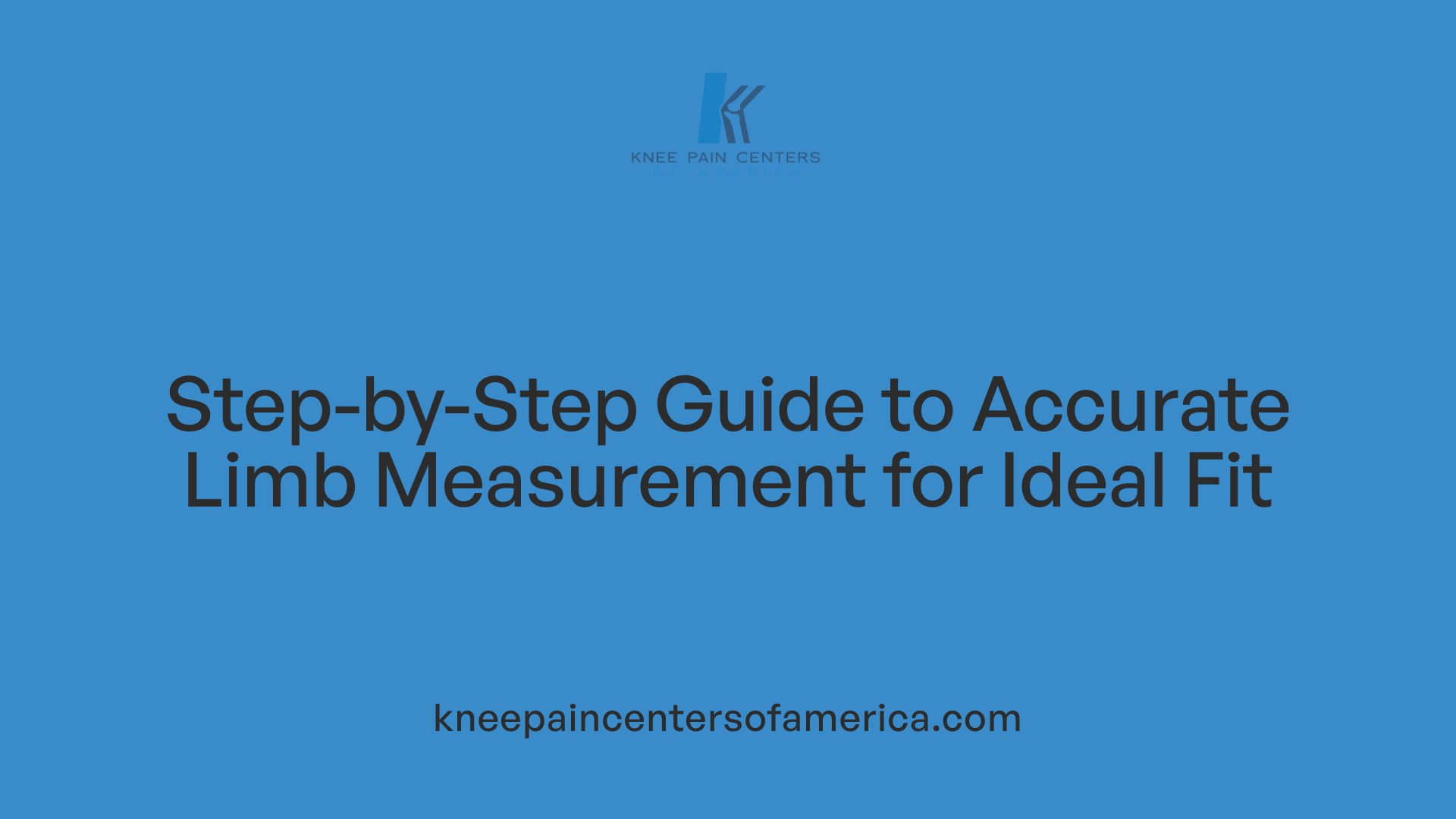Getting the Right Fit with Tubigrip Support Bandages
Tubigrip is a versatile support bandage used to manage sprains, strains, swelling, and other soft tissue injuries. Proper sizing of Tubigrip is essential for effective support, comfort, and therapeutic benefit. This article provides a comprehensive guide on how to measure, select, and apply Tubigrip correctly, ensuring users get the most out of this adaptable support solution.
Measuring for Proper Tubigrip Fit

How to measure limb circumference accurately
To ensure a proper fit when selecting Tubigrip, begin by measuring the circumference of the limb at the specific area requiring support. Use a flexible measuring tape and wrap it evenly around the widest part of the joint or area, such as the wrist, ankle, elbow, or knee. Make sure the tape is snug but not tight to get an accurate measurement. Record this circumference in centimeters or inches. This precise measurement is essential because Tubigrip sizes are based on limb circumferences.
Using the measurement to choose the correct size
Once you have the limb's circumference, divide that measurement by two. Tubigrip sizes correspond to the width of the bandage, which ranges from 1.5 inches for infants to over 4.5 inches for larger limbs. Refer to the sizing chart, which categorizes sizes from A through L, along with the specific limb circumference ranges:
| Size |
Limb Circumference Range |
Suggested Uses |
Additional Details |
| Size A |
1-1.5 inches / 2.5-3.8 cm |
Infants' small wrists and ankles |
Thin, delicate areas |
| Size B |
2-2.5 inches / 5.1-6.4 cm |
Small hands and wrists |
Suitable for delicate support |
| Size C |
2.75 inches / 7 cm |
Medium wrists and ankles |
Supports small joints |
| Size D |
3 inches / 7.6 cm |
Large wrists, medium ankles |
Versatile for various joints |
| Size E |
3.5 inches / 8.9 cm |
Large elbows, knees |
For bigger limbs |
| Size F |
4 inches / 10.2 cm |
Large knees and small thighs |
Provides firmer support |
| Size G |
4.5 inches / 11.4 cm |
Extra large knees and medium thighs |
Heavier support |
Choose the size which most closely matches half of your limb’s measurement, ensuring a snug fit without discomfort.
Application technique to ensure snug fit
To apply Tubigrip correctly, cut it to twice the length of the limb segment you're supporting, adding an extra 2-3 cm for overlap. Pull it onto the limb like a stocking, starting from the toes or fingers and working up. Double the bandage over the limb to provide even support. The upper edge should sit 2-3 cm higher than the lower edge to prevent slipping.
Ensure it fits snugly but does not restrict circulation. Since it’s elastic, it conforms to the body's contours and provides gentle, consistent compression. This positioning promotes venous and lymphatic return, supporting swelling reduction and soft tissue healing.
More information
For further guidance, consult the Tubigrip measuring guide and sizing instructions available upon request. Proper measurement and application are crucial for effective support and comfort.
Range of Sizes and Specifications Available
 Tubigrip support bandages come in a variety of sizes to accommodate different limb circumferences, from infants to large trunk areas. The sizes are labeled from A to M, with each size matching specific measurement ranges in inches and centimeters. For instance, Size A is suitable for limb circumferences of approximately 3.9 to 5.7 inches (10-14.5 cm), making it ideal for infants or small limbs. On the other end, Size M fits larger measurements, roughly 46.9 to 65.7 inches (119-167 cm), suitable for adults with larger extremities.
Tubigrip support bandages come in a variety of sizes to accommodate different limb circumferences, from infants to large trunk areas. The sizes are labeled from A to M, with each size matching specific measurement ranges in inches and centimeters. For instance, Size A is suitable for limb circumferences of approximately 3.9 to 5.7 inches (10-14.5 cm), making it ideal for infants or small limbs. On the other end, Size M fits larger measurements, roughly 46.9 to 65.7 inches (119-167 cm), suitable for adults with larger extremities.
These bandages are available in different lengths, primarily 1 meter (about 3.3 feet) and 10 meters (about 33 feet). They are offered in two color options: natural and beige, allowing users to select according to preference or need.
Regarding material composition, Tubigrip consists of cotton stockinette intertwined with elastic threads that contain latex, providing the necessary elastic support. The blend includes viscose, elastane, and polyamide, which ensures elasticity, durability, and comfort. Since it contains latex, some individuals with latex allergies may need to avoid it.
Each size has a specific flat width, useful for precise application. For example, Size B has a width of 2-1/2 inches, suitable for small wrists or ankles, while Size G measures 4-1/2 inches, ideal for larger knees or thighs.
Proper fitting is crucial for effective support. Users should measure the circumference around the widest part of the joint or limb being supported to select the correct size. The bandages can be cut to the required length, usually twice the limb's measurement plus an additional 2-3 cm for overlap, and can be repositioned, washed, and reused without the need for pins or tape.
Overall, the diverse sizing options ensure that Tubigrip can be customized to individual needs, providing effective support for soft tissue injuries, swelling, and weak joints.
Understanding the Size Chart and Selection Process
 Tubigrip comes in a variety of sizes, all determined by the circumference of the limb or joint they are intended to support. To choose the correct size, the first step is to measure around the widest part of the area needing support. For example, you might measure around the center of the knee, ankle, or forearm, depending on the injury or condition.
Tubigrip comes in a variety of sizes, all determined by the circumference of the limb or joint they are intended to support. To choose the correct size, the first step is to measure around the widest part of the area needing support. For example, you might measure around the center of the knee, ankle, or forearm, depending on the injury or condition.
The sizing chart covers options labeled from A to L, with each size corresponding to specific limb measurements. For instance, size A is suitable for smaller limbs like infant wrists or feet, measuring about 1.5 inches wide, while size G, which is 4.5 inches wide, fits larger knees or thighs. These sizes are detailed with particular circumference ranges, enabling precise selection.
Matching measurements with sizes involves comparing the limb circumference to the chart's specified ranges. If your measurement falls between two sizes, it is generally advisable to choose the larger size for comfort and effectiveness. Since Tubigrip can be cut to length and worn double, this flexibility helps provide appropriate support across different body parts.
It's important to consider that sizes can overlap, and personal comfort may dictate slight adjustments. The goal is to ensure even, firm support without restricting circulation. Using the sizing guide, usually available as a downloadable document, helps ensure accurate fit and optimal therapeutic benefit.
Size Options and Measurement Details:
| Size |
Width (inches) |
Typical Use |
Limb Circumference Range |
Additional Details |
| A |
1.5 |
Infant feet, arms |
Up to 4 inches (10 cm) |
Suitable for small joints |
| B |
2.5 |
Small hands, wrists |
4-6 inches (10-15 cm) |
Commonly used for wrists |
| C |
2.75 |
Medium wrists, ankles |
6-8 inches (15-20 cm) |
Covers elbows and small knees |
| D |
3 |
Large wrists, ankles |
8-10 inches (20-25 cm) |
Fits medium joints |
| E |
3.5 |
Large elbows, ankles |
10-12 inches (25-30 cm) |
Supports larger limbs |
| F |
4 |
Large knees, small thighs |
12-14 inches (30-35 cm) |
Used for knee support |
| G |
4.5 |
Extra large knees, medium thighs |
14-16 inches (35-40 cm) |
Suitable for bigger limbs |
Understanding these sizing parameters helps in selecting the appropriate Tubigrip, ensuring effective support and comfort.
Guidance on Application and Size Selection
 Where can I find guidance on sizing and application of Tubigrip?
Guidance on the correct sizing and application of Tubigrip is typically available in detailed product literature, instruction leaflets, and on the manufacturer's website. These resources offer specific size ranges based on limb circumference measurements in inches and centimeters.
Where can I find guidance on sizing and application of Tubigrip?
Guidance on the correct sizing and application of Tubigrip is typically available in detailed product literature, instruction leaflets, and on the manufacturer's website. These resources offer specific size ranges based on limb circumference measurements in inches and centimeters.
To choose the right size, measure around the widest part of the joint or limb area that needs support, like the knee or ankle. Once you have the measurement, consult the sizing chart to find the corresponding size label, which ranges from size A for small limbs to size L for larger ones.
Tubigrip is available in various lengths, including 10 meters, 1 meter, and 0.5 meters, and in different widths suitable for different body parts. The sizes are labeled from A (smallest) to L (largest), matching specific limb circumferences.
Proper application involves cutting the Tubigrip to the correct length—about twice the distance of the limb or joint to be supported, plus an extra 2-3 cm for overlap. You then pull it on like a stocking and fold the top edge back over the limb with an overlap. This ensures even support and pressure.
Additional guidance can be obtained from the tape measuring guide available upon request, which provides tips for accurate measurement and fitting. Correct sizing and application are essential for the support to be effective, preventing issues like circulation restriction or inadequate compression.
Choosing the Correct Diameter and Length for Support
 When selecting the appropriate Tubigrip, it’s crucial to consider the specific support needs of your limb or joint. The right size ensures effective compression and comfort, whether you're managing swelling, sprains, or strains.
When selecting the appropriate Tubigrip, it’s crucial to consider the specific support needs of your limb or joint. The right size ensures effective compression and comfort, whether you're managing swelling, sprains, or strains.
Start by measuring the circumference of the limb or joint at its widest point—this could be around the wrist, ankle, knee, or elbow. Use a flexible tape measure and take the measurement twice for accuracy, as swelling or movement can cause variations throughout the day.
The sizing chart categorizes Tubigrip into different sizes labeled from A to G, with each size suited for specific limb widths and lengths. For example, size A is best for small wrists and infants, measuring 1-1/2 inches (3.8 cm) wide, while larger sizes like G are suitable for larger knees and thighs, up to 4-1/2 inches (11.4 cm) wide.
Additionally, consider the length of the Tubigrip roll, which is generally 33 feet (10 meters). For most applications, you should cut the Tubigrip to twice the length of your limb segment plus an extra 2-3 cm to allow for overlap, ensuring it covers the area comfortably without gaps.
Adjustments can be made by repositioning or trimming the bandage for a snug fit. When applying, pull the bandage like a stocking and double it over the limb so it provides even support. The material conforms to the body's contours, reducing swelling and supporting circulation.
Ultimately, accurately measuring and selecting the size that matches your limb circumference helps achieve the necessary compression—often between 10-20 mmHg when worn double thickness—without restricting movement.
Proper fitting not only maximizes the effectiveness of the support but also ensures comfort, allowing you to wear Tubigrip during daily activities like walking or working, while avoiding compression during rest or exercise.
Final Thoughts on Tubigrip Sizing and Application
Choosing the right size for your Tubigrip is essential for effective support and comfort. Proper measurement, understanding the sizing chart, and following application guidelines ensure that you receive the benefits of optimal compression and support. Whether you're using Tubigrip for swelling, support, or injury management, accurate sizing is key to a successful outcome. Always refer to the manufacturer’s instructions and seek professional advice if needed.
References